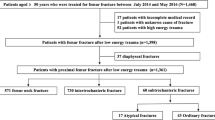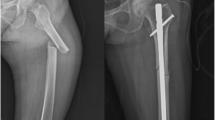Abstract
Summary
There still remains controversy on the pathomechanism of atypical femoral fracture (AFF). The angle of lateral bowing and bone mineral density showed significant differences between subtrochanteric and diaphyseal atypical fracture groups. In addition to the use of bisphosphonate, mechanical factors might play important roles in the occurrence of AFFs.
Introduction
Although AFF could be divided into subtrochanteric and diaphyseal fracture according to the location of fractures, there is a lack of evidence regarding differences between two fractures and etiology of the occurrence. The aim of study is to determine differences between atypical subtrochanteric and diaphyseal fracture in Korean population.
Methods
Between February 2010 and March 2015, 51 AFFs in 40 patients were included in this study. Their medical records were retrospectively reviewed. The AFF patients satisfied all the diagnostic criteria of the 2014 revised edition of the ASMBR. To analyze the differences according to the location of fracture, the AFFs were divided into subtrochanteric (n = 16) and diaphyseal (n = 35) fracture groups. The following factors were compared between two groups: patients’ demographics, underlying diseases, laboratory findings (serum-25(OH) VitD3, osteocalcin, c-telopeptide, ALP, Ca, and P), bone mineral density (BMD), duration of bisphosphonate (BP) usage, and lateral bowing of the femur at time of the fracture.
Results
All AFFs happened in female patients (mean age, 73.8 years) who have received bisphosphonate treatments except three patients. The mean duration of bisphosphonate usage was 95.3 months. Between the two groups, demographic data (age, height, weight, and BMI), underlying diseases, laboratory findings, hip BMD, and duration of BP treatment were comparable to each other (p > 0.05). However, the subtrochanteric fracture group showed higher FNSBA (femoral neck shaft bowing angle, p < 0.001) and spine BMD (p = 0.014) compared to the diaphyseal fracture group.
Conclusions
Angle of lateral bowing (FNSBA) and spine BMD showed significant differences between subtrochanteric and diaphyseal atypical fracture groups. According to our results, femoral bowing and spine BMD may play important roles in the AFF locations.


Similar content being viewed by others
References
Bottai V, Giannotti S, Dell'osso G et al (2014) Atypical femoral fractures: retrospective radiological study of 319 femoral fractures and presentation of clinical cases. Osteoporos Int 25:993–997
Unnanuntana A, Saleh A, Mensah KA et al (2013) Atypical femoral fractures: what do we know about them?: AAOS exhibit selection. J Bone Joint Surg Am 95:e8 1–e813
Allen MR, Burr DB (2011) Bisphosphonate effects on bone turnover, microdamage, and mechanical properties: what we think we know and what we know that we don’t know. Bone 49:56–65
Park-Wyllie LY, Mamdani MM, Juurlink DN, Hawker GA, Gunraj N, Austin PC, Whelan DB, Weiler PJ, Laupacis A (2011) Bisphosphonate use and the risk of subtrochanteric or femoral shaft fractures in older women. JAMA 305:783–789
Wang Z, Ward MM, Chan L, Bhattacharyya T (2014) Adherence to oral bisphosphonates and the risk of subtrochanteric and femoral shaft fractures among female medicare beneficiaries. Osteoporos Int 25:2109–2116
Kang JS, Won YY, Kim JO, Min BW, Lee KH, Park KK, Song JH, Kim YT, Kim GH (2014) Atypical femoral fractures after anti-osteoporotic medication: a Korean multicenter study. Int Orthop 38:1247–1253
Saita Y, Ishijima M, Mogami A, Kubota M, Baba T, Kaketa T, Nagao M, Sakamoto Y, Sakai K, Homma Y, Kato R, Nagura N, Miyagawa K, Wada T, Liu L, Matsuoka J, Obayashi O, Shitoto K, Nozawa M, Kajihara H, Gen H, Kaneko K (2015) The incidence of and risk factors for developing atypical femoral fractures in Japan. J Bone Miner Metab 33:311–318
Gedmintas L, Solomon DH, Kim SC (2013) Bisphosphonates and risk of subtrochanteric, femoral shaft, and atypical femur fracture: a systematic review and meta-analysis. J Bone Miner Res 28:1729–1737
Hyodo K, Nishino T, Kamada H et al (2016) Location of fractures and the characteristics of patients with atypical femoral fractures: analyses of 38 Japanese cases. In: J Bone Miner Metab
Kim SM, Park YS, Moon YW, Kang SH, Yeo I, Oh SM, Lim SJ (2016) Atypical complete femoral fractures associated with bisphosphonate use or not associated with bisphosphonate use: is there a difference? Biomed Res Int 2016:4753170, 1, 8
Chen LP, Chang TK, Huang TY, Kwok TG, Lu YC (2014) The correlation between lateral bowing angle of the femur and the location of atypical femur fractures. Calcif Tissue Int 95:240–247
Morin SN, Wall M, Belzile EL, Godbout B, Moser TP, Michou L, Ste-Marie LG, de Guise JA, Rahme E, Brown JP (2016) Assessment of femur geometrical parameters using EOS imaging technology in patients with atypical femur fractures; preliminary results. Bone 83:184–189
Shane E, Burr D, Abrahamsen B, Adler RA, Brown TD, Cheung AM, Cosman F, Curtis JR, Dell R, Dempster DW, Ebeling PR, Einhorn TA, Genant HK, Geusens P, Klaushofer K, Lane JM, McKiernan F, McKinney R, Ng A, Nieves J, O'Keefe R, Papapoulos S, Howe TS, van der Meulen MCH, Weinstein RS, Whyte MP (2014) Atypical subtrochanteric and diaphyseal femoral fractures: second report of a task force of the American Society for Bone and Mineral Research. J Bone Miner Res 29:1–23
Lo JC, Hui RL, Grimsrud CD, Chandra M, Neugebauer RS, Gonzalez JR, Budayr A, Lau G, Ettinger B (2016) The association of race/ethnicity and risk of atypical femur fracture among older women receiving oral bisphosphonate therapy. Bone 85:142–147
Koeppen VA, Schilcher J, Aspenberg P (2012) Atypical fractures do not have a thicker cortex. Osteoporos Int 23:2893–2896
Saita Y, Ishijima M, Mogami A, Kubota M, Baba T, Kaketa T, Nagao M, Sakamoto Y, Sakai K, Kato R, Nagura N, Miyagawa K, Wada T, Liu L, Obayashi O, Shitoto K, Nozawa M, Kajihara H, Gen H, Kaneko K (2014) The fracture sites of atypical femoral fractures are associated with the weight-bearing lower limb alignment. Bone 66:105–110
Bauer DC (2012) Atypical femoral fracture risk in patients treated with bisphosphonates. Arch Intern Med 172:936–937
Hayashi K, Aono M, Shintani K, Kazuki K (2014) Bisphosphonate-related atypical femoral fracture with bone metastasis of breast cancer: case report and review. Anticancer Res 34:1245–1249
Hsu JH, Tsai MY, Chen CK et al (2013) Bisphosphonate-related atypical femoral fracture. Kaohsiung J Med Sci 29:345–346
Parron Cambero R, Rey Lopez A, Tome-Bermejo F et al (2013) Atypical bilateral femoral shaft fracture in patient treated with bisphosphonates. Eur J Orthop Surg Traumatol 23(Suppl 2):S219–S223
Iwata K, Mashiba T, Hitora T, Yamagami Y, Yamamoto T (2014) A large amount of microdamages in the cortical bone around fracture site in a patient of atypical femoral fracture after long-term bisphosphonate therapy. Bone 64:183–186
Lim HS, Kim CK, Park YS, Moon YW, Lim SJ, Kim SM (2016) Factors associated with increased healing time in complete femoral fractures after long-term bisphosphonate therapy. J Bone Joint Surg Am 98:1978–1987
Author information
Authors and Affiliations
Corresponding author
Ethics declarations
The study protocol was approved by the Institutional Review Board at our institution.
Conflicts of interest
None.
Rights and permissions
About this article
Cite this article
Cho, YJ., Kang, KC., Chun, YS. et al. Critical differences between subtrochanteric and diaphyseal atypical femoral fractures: analyses of 51 cases at a single institution in Korean population. Arch Osteoporos 13, 53 (2018). https://doi.org/10.1007/s11657-018-0457-1
Received:
Accepted:
Published:
DOI: https://doi.org/10.1007/s11657-018-0457-1




